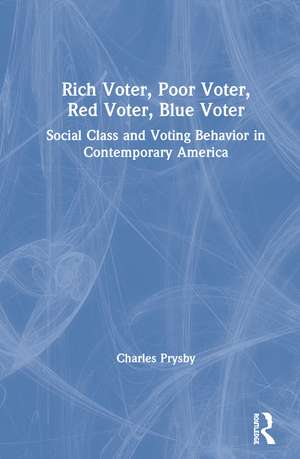Rich Voter, Poor Voter, Red Voter, Blue Voter: Social Class and Voting Behavior in Contemporary America
Autor Charles Prysbyen Limba Engleză Hardback – 15 iun 2020
Charles Prysby analyzes this development in American politics in a way that is understandable to a wide audience, not just scholars in this field. Drawing on a wealth of survey data, this study describes and explains the underlying causes of the change that has taken place over the past two decades, identifying how social class is directly related to partisan choice. Attitudes on race and immigration, on social and moral issues, and on economic and social welfare policies are all part of the explanation of this 21st century development in American political trends.
Rich Voter, Poor Voter, Red Voter, Blue Voter: Social Class and Voting Behavior in Contemporary America is essential reading for scholars, students, and all others with an interest in American elections and voting behavior.
| Toate formatele și edițiile | Preț | Express |
|---|---|---|
| Paperback (1) | 348.57 lei 6-8 săpt. | |
| Taylor & Francis – 10 iun 2020 | 348.57 lei 6-8 săpt. | |
| Hardback (1) | 998.21 lei 6-8 săpt. | |
| Taylor & Francis – 15 iun 2020 | 998.21 lei 6-8 săpt. |
Preț: 998.21 lei
Preț vechi: 1217.34 lei
-18% Nou
Puncte Express: 1497
Preț estimativ în valută:
191.03€ • 199.19$ • 158.76£
191.03€ • 199.19$ • 158.76£
Carte tipărită la comandă
Livrare economică 20 martie-03 aprilie
Preluare comenzi: 021 569.72.76
Specificații
ISBN-13: 9780367334284
ISBN-10: 0367334283
Pagini: 188
Dimensiuni: 152 x 229 x 13 mm
Greutate: 0.39 kg
Ediția:1
Editura: Taylor & Francis
Colecția Routledge
Locul publicării:Oxford, United Kingdom
ISBN-10: 0367334283
Pagini: 188
Dimensiuni: 152 x 229 x 13 mm
Greutate: 0.39 kg
Ediția:1
Editura: Taylor & Francis
Colecția Routledge
Locul publicării:Oxford, United Kingdom
Public țintă
Postgraduate and UndergraduateCuprins
1. A Changing Class Alignment? 2. Conceptualizing Social Class 3. Class and Voting in Modern American Politics 4. Race, Class, and the Politics of White Identity 5. Cultural Issues, Class, and Voting 6. Economic Issues, Social Class, and Voting 7. Analyzing the 2012 and 2016 Presidential Elections 8. Conclusion: Social Class and Voting in the 21st Century
Notă biografică
Charles Prysby is a professor of Political Science at the University of North Carolina at Greensboro. He specializes in American elections, voting behavior, and political parties. His most recent book, coauthored with David Holian, is Candidate Character Traits in Presidential Elections (Routledge, 2015).
Recenzii
'Excellent! An over-time analysis of the factors that impact elections from one of the few people able to do it. From class and culture to white identity, it is all there. Special attention is paid to the vote in 2012 and 2016. An original and creative contribution to our understanding of the dynamics of elections. Mandatory reading!'
William Crotty, Thomas P. O'Neill, Jr. Chair in Public Life and Emeritus Professor of Political Science, Northeastern University
'This book offers a much-needed update on social class and voting behavior in presidential elections. Prysby gives careful thought on how to measure social class, and conducts a systematic analysis that is both well executed and convincing. This work makes a major contribution to the academic literature. Highly recommended to anyone who wants to understand how the relationship has changed between social class and voting behavior during the first two decades of this century.'
Peter L. Francia, East Carolina University
'Media pundits seized on the power of Trump’s populist appeal, while sociologists and political scientists focused their attention on surveys of economic anxieties and attitudes toward race and immigration, attempting to adjudicate between the relative importance of each. In Rich Voter, Poor Voter, Red Voter, Blue Voter, Charles Prysby takes us beyond these fairly narrow attempts to explain Trump’s victory, instead situating the rather remarkable events of 2016 in a much broader pattern of class-based voting by whites in America, a trend that has been growing stronger in recent years. Prysby’s book should be required reading for those looking for an introduction to class and political behavior among whites, because it clearly and methodically reviews its history, its relationship to other important cleavages in voting behavior, and its implications for future political alignments.'
Perspectives on Politics
William Crotty, Thomas P. O'Neill, Jr. Chair in Public Life and Emeritus Professor of Political Science, Northeastern University
'This book offers a much-needed update on social class and voting behavior in presidential elections. Prysby gives careful thought on how to measure social class, and conducts a systematic analysis that is both well executed and convincing. This work makes a major contribution to the academic literature. Highly recommended to anyone who wants to understand how the relationship has changed between social class and voting behavior during the first two decades of this century.'
Peter L. Francia, East Carolina University
'Media pundits seized on the power of Trump’s populist appeal, while sociologists and political scientists focused their attention on surveys of economic anxieties and attitudes toward race and immigration, attempting to adjudicate between the relative importance of each. In Rich Voter, Poor Voter, Red Voter, Blue Voter, Charles Prysby takes us beyond these fairly narrow attempts to explain Trump’s victory, instead situating the rather remarkable events of 2016 in a much broader pattern of class-based voting by whites in America, a trend that has been growing stronger in recent years. Prysby’s book should be required reading for those looking for an introduction to class and political behavior among whites, because it clearly and methodically reviews its history, its relationship to other important cleavages in voting behavior, and its implications for future political alignments.'
Perspectives on Politics
Descriere
This book examines the changing relationship between social class and voting behavior in contemporary America. Drawing on a wealth of survey data, this study describes and explains the underlying causes of the change that has taken place over the past two decades, identifying how social class is directly related to partisan choice.
